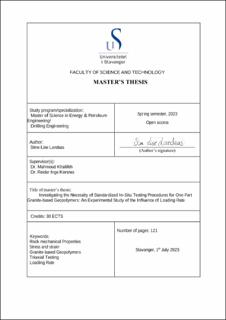| dc.description.abstract | Ordinary Portland cement (OPC) is the most popular choice for cementing material for petroleum well cementing. Since cement is used in the petroleum industry as an essential part of creating zonal isolation and ensuring well integrity during and after decommissioning. The drawback with using OPC is responsible for 8% of the worlds carbon dioxide emissions and to produce one tonne of OPC, emits 0.9 tonne of CO2. Hence the objective of this thesis to test if a rock geopolymer cement can be an alternative to OPC. Which have up to 80% less emission of CO2 compared to OPC.
This thesis is one part of a three-part study of the properties to the rock based geopolymer Just add water (JAW-B). JAW-B is a granite-based rock-based polymer where all the activators are in the dry phase and only water is to be added to make the cement. The objective of thesis is to test the impact of different loading rates on the in-situ mechanical properties of the rock-based geopolymer JAW-B. A triaxial cell was used to simulate the downhole conditions and in-situ stress conditions of a petroleum wellbore. The test samples of JAW-B were prepared and cured for one week at 90°C at 2000 psi. A total of 18 JAW-B test samples were prepared and subjected to nine tests, each with duplicates, utilizing three different loading rates (0.5, 12, and 17.97+ MPa/min) and three distinct confining pressures (8, 17.2, and 26 MPa)
Regarding Young's modulus, holding the piston load rate constant at 0.5 MPa/min and increasing the confining pressure from 8 MPa to 17.2 MPa resulted in a change in Young's modulus from a range of 0.71-0.73 GPa to 0.51-0.72 GPa. Further increasing the confining pressure from 17.2 MPa to 26 MPa led to an increase in Young's modulus to 1.01-1.09 GPa. Similarly, when holding the piston load rate constant at 12 MPa/min, increasing the confining pressure resulted in an increase in Young's modulus. A similar trend was observed for a piston load rate range of 17.97-23.3 MPa/min. Overall, increasing the confining pressure led to an increase in Young's modulus.
Poisson's ratio was also examined in relation to confining pressure and piston loading rate. The results showed that increasing the confining pressure generally resulted in changes in Poisson's ratio, except for the case of a piston load rate of 0.5 MPa/min, where no noticeable change was observed. Increasing the piston loading rate generally led to an increase in Poisson's ratio, indicating that the samples became more ductile as the applied stress increased.
The compressive strength of the samples was influenced by both confining pressure and piston loading rate. Increasing the confining pressure generally led to an increase in compressive strength, while the effect of piston loading rate was more variable and dependent on other factors.
The bulk modulus of JAW-B was found to increase as the confining pressure increased from 8 to 26 MPa. This suggests that the material became less compressible and more resistant to changes in shape or volume under higher confining pressures.
In conclusion, this study demonstrates that changes in both confining pressure and piston loading rate can significantly impact the mechanical properties of JAW-B.
Based on the results of this thesis, it is recommended to conduct further testing on JAW-B geopolymer at low and high piston load rates under a confining pressure of 8 MPa. To qualify and establish a standard for JAW-B as an OPC substitute in well cementing, further testing against OPC benchmark properties is required. The obtained results are promising, but additional testing is necessary to ensure quality. | |
